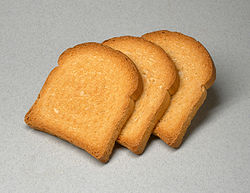Zwieback
This article needs additional citations for verification. (September 2019) |
 | |
| Type | Bread |
|---|---|
| Place of origin | Germany |
| Region or state | East Prussia |
| Main ingredients | Flour, eggs, sugar |
Zwieback (German: [ˈt͡sviːbak] ) is a form of rusk eaten in Austria, Belgium, Bosnia-Herzegovina, Bulgaria, Croatia, France, Germany, Greece, Italy, Luxembourg, The Netherlands, North Macedonia, Poland, Scandinavia, Serbia, Slovenia, Switzerland and Turkey. It is a type of crisp, sweetened bread, made with eggs and baked twice. It originated in East Prussia. According to Fabian Scheidler, Albrecht von Wallenstein invented zwieback to feed his mercenary army during the Thirty Years' War.[1] The Mennonites brought Zwieback to the Russian Empire; before the Russian Revolution, when many emigrated to the west, they brought Zwieback to Canada, the United States and other parts of the world.
There are two types of zwieback. One type is made by pinching round pieces of dough, placing one piece on top of another, pressing them together by pushing a finger down through both pieces. It is then baked and served as warm soft rolls. This type is identified with Mennonites. The other type is a bread sliced before it is baked a second time, which produces crisp, brittle slices that closely resemble melba toast.[2] Zwieback is commonly used to feed teething babies [2] and as the first solid food for patients with an upset stomach.
The name comes from German zwei ("two") or zwie ("twi-"), and backen, meaning "to bake".[3] Zwieback hence literally translates to "twice-baked". The French and Italian names, respectively, biscotte and fette biscottate have the same origin, biscotto (biscuit), which also means twice ("bis-") baked (-"cotto"). The Slovene name is prepečenec which would imply baked over ordinary or overbaked. The Serbo-Croatian name is dvopek which, again, is literally twice (dvo) baked (pek).
Russian Mennonite Zwieback
[edit]Russian Mennonite zwieback, called Tweebak in Plautdietsch, is a yeast bread roll formed from two pieces of dough that are pulled apart when eaten. Placing the two balls of dough one on top of the other so that the top one does not fall off during the baking process is part of the art and challenge that must be mastered by the baker. Traditionally, this type of zwieback is baked Saturday and eaten Sunday morning and for afternoon Faspa (Standard German: "Vesper"),[4] a light meal.[5][6]
This zwieback originated in the port cities of the Netherlands or Danzig, where toasted, dried buns were used to provision ships. Mennonite immigrants from the Netherlands, who settled in around Danzig in West Prussia continued this practice and brought it to Russia, when they migrated to new colonies in what is today Ukraine.[4]
Traditionally, zwieback are made using lard instead of butter or a mixture of the two. As such, zwieback is very rich and does not need butter when being eaten, although jelly or jam both go quite well. Many zwieback recipes do not use modern units of measurement, instead relying on anecdotal measurements handed down through the generations.
See also
[edit]- Biscotti
- Brandt (company)
- Russian Mennonite zwieback (Tweebak)
- Toast
- Russian Mennonite
- Rusk
- Mennonite cuisine
References
[edit]- ^ Fabian Scheidler, The End of the Megamachine: A Brief History of a Failing Civilization, Washington: Zero Books, 2020, p. 103. Scheidler references Robert Rebitsch, Wallenstein: Biographie eines Machtmenschen, Vienna, 2010, p. 132.
- ^ a b "Zwieback – Medical Dictionary Definition". Archived from the original on 2016-08-26. Retrieved 2008-04-05.
- ^ zwieback – Health Information About zwieback | Encyclopedia.com: Dictionary Of Food and Nutrition
- ^ a b Voth, Norma Jost, "Mennonite Foods & Folkways from South Russia, Volumes I", pp. 35–55. Good Books, 1990. ISBN 0-934672-89-X
- ^ Wiese, Luella Toevs (1993-01-01). Franz Toevs and His Descendants. Tennessee Valley Publishing. p. 14. ISBN 9781932604276.
- ^ "Faspa Country: a Herbert story". Archived from the original on 2013-01-15. Retrieved 2012-06-24.
